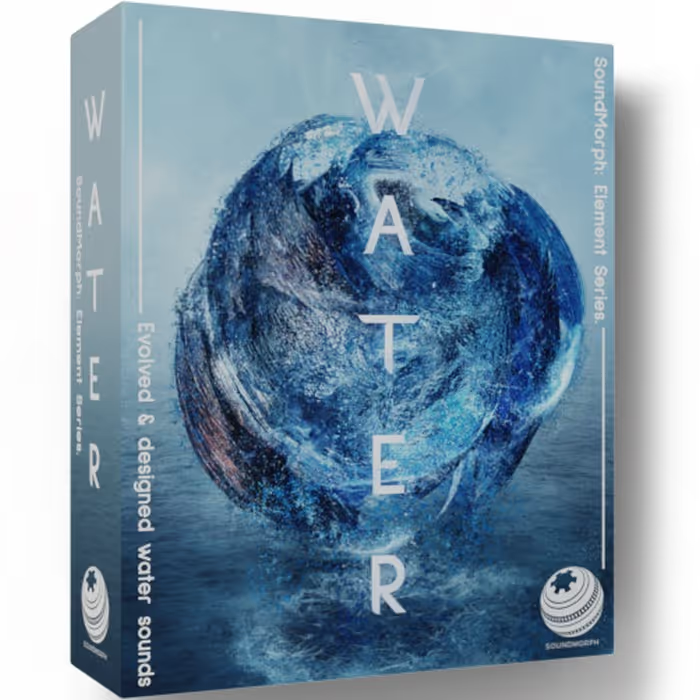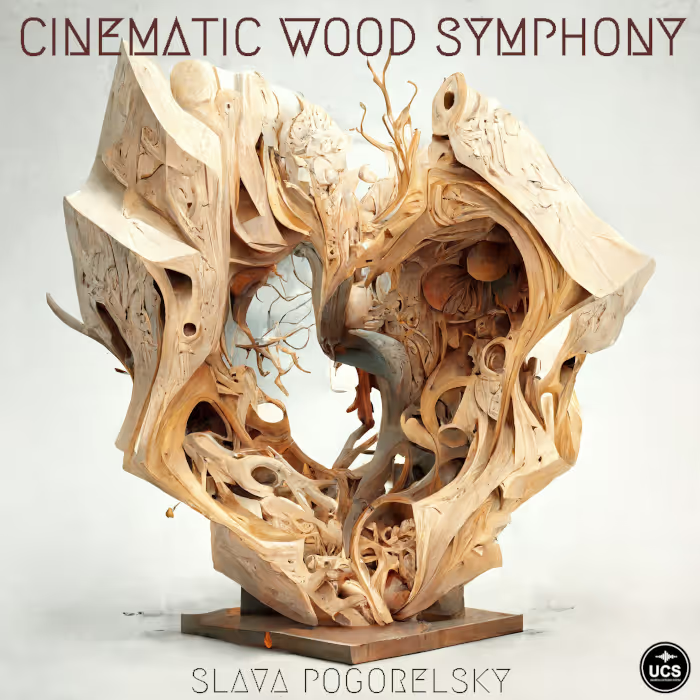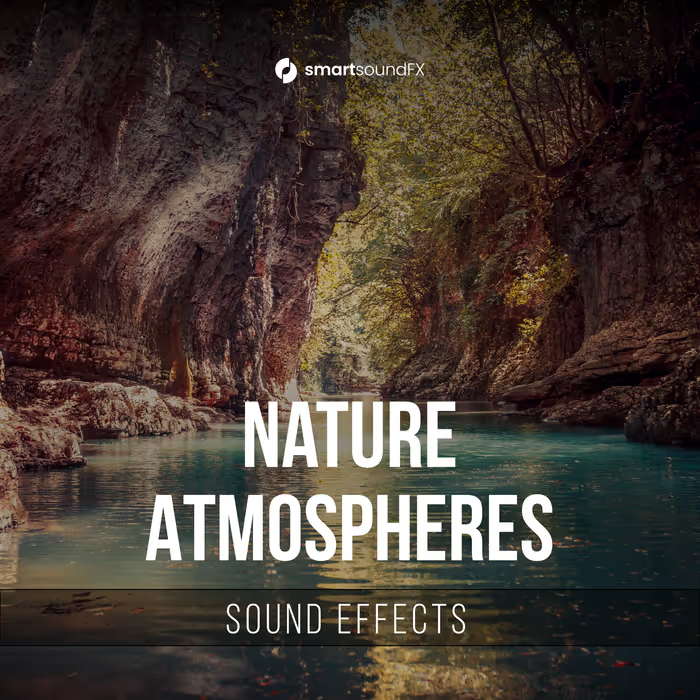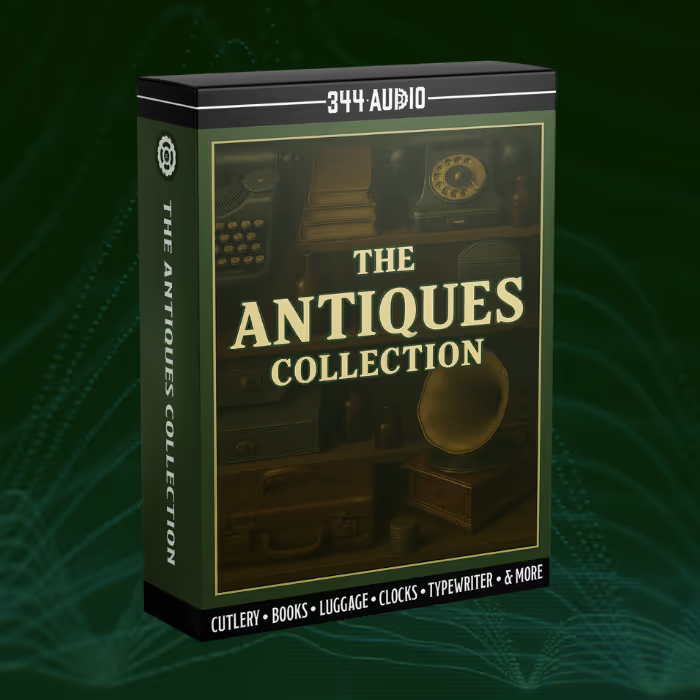Any true fan of medical dramas will remember ER — one of the longest running medical dramas in TV history with 331 episodes spanning 15 seasons! ER writer/producer R. Scott Gemmill teamed up with two other ER alumni, executive producers John Wells and Noah Wyle, on a new emergency room-based series The Pitt, which is now streaming on Max.
The Pitt provides non-stop, fast-paced action, prizes accuracy, and gives a realistic portrayal of healthcare workers. Each episode is another hour on the clock in a nightmarish E.R. shift. It’s intense and captivating, from split-second life-saving decisions to complex relationships among co-workers.
MPSE Award-winning supervising sound editor Bryan Parker at Formosa Group talks about how they keep clarity in rapid-fire dialogue with dense medical jargon, how they created movement in the background crowd sound by experimenting with miking during loop group, how they built chaos through specificity in the effects layers, and much more!
The Pitt | Official Trailer | Max
How did showrunner R. Scott Gemmill want to approach sound for The Pitt? With his experience of working on the TV series ER, he certainly knows his medical shows! How did he want to use sound to make The Pitt feel intense?

Bryan Parker (BP): Scott Gemmill And John Wells (executive producer/director of two episodes) wanted a raw, real, sometimes chaotic feel to the sound of the fictional Pittsburgh Trauma Medical Hospital’s Emergency Department called “The Pitt,” with bursts of patients’ voices, equipment, and indications of activity all around this large, wide space.
But it was important to avoid simply stacking layers and ending up with a steady din. The original idea was that there would be no music at all, and of course, that leaves a lot of space to fill up with sound, and an opportunity to make sure that all that sound is carefully composed to enhance the setting and the story best.
They wanted to feel the space, so I walked the set with our producer Terri Murphy to see the layout. They gave us printed maps of various sizes to help us visualize where the scenes were taking place around the ED, and made sure we understood what density and quality we were going for in different places.
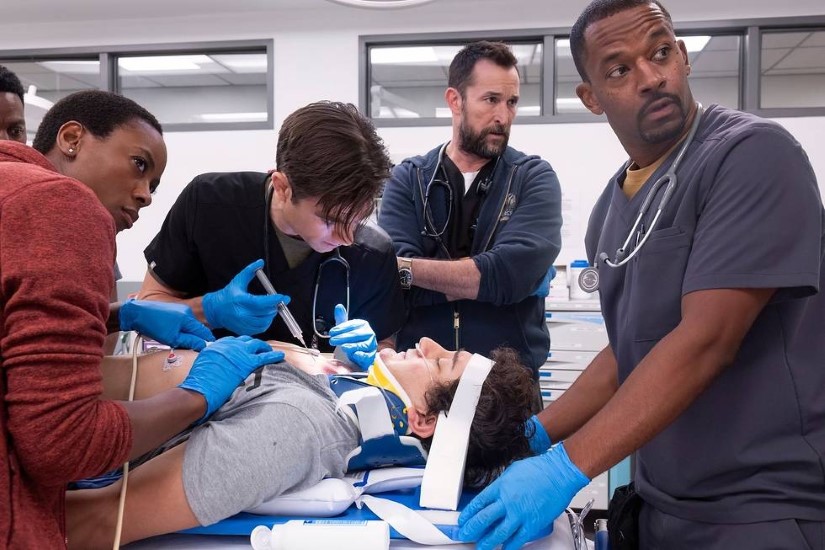
What did you get from the production sound team in terms of dialogue tracks? Did you get any location ambience? What were some of your challenges with the fast-paced dialogue on the show?
BP: Production audio was generally 12 tracks. Production mixer Von Varga gave us a mix track, boom, and 6-10 lavaliers.
The first couple of episodes had more iso mics spread across two recorders, so it took a little bit of work to get all that organized, as I recall. The dialogue moves very, very fast in this show — with some dense medical jargon — and that can lead to some overlaps in the edit. Our incredible dialogue editor Kristen Hirlinger handled most of this, taking my notes and pulling alternate takes for a word or a syllable here and there. There were occasional mispronounced words, for a medication or a procedure, and Dr. Joe Sachs advised on where we needed to fix those, with alternate takes or with ADR. Vince Tennant cut most of the ADR this season.
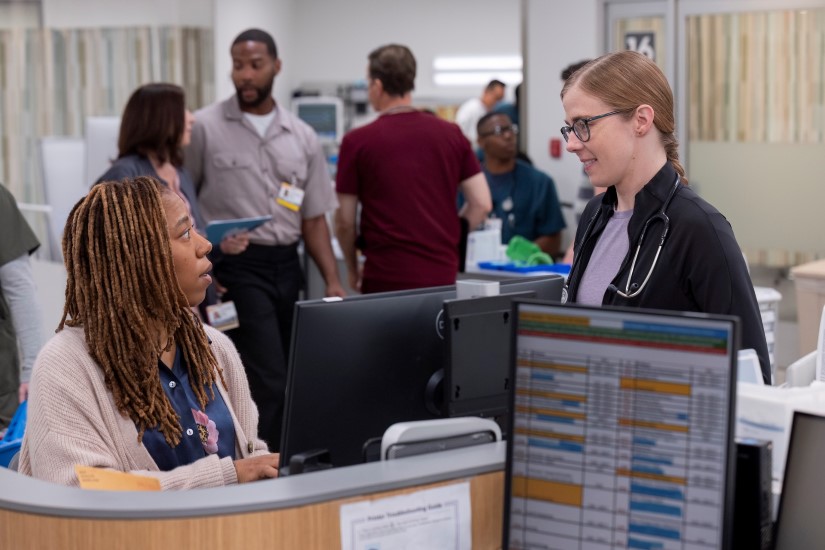
The show embraces hyper-realism, with non-stop action and busy backgrounds including medical alarms and intercom announcements. What went into the sound of this setting? (Any useful indie sound libraries? What about recording loop group for the BGs? Any help from foley to fill out the backgrounds?)
BP: The busy backgrounds are an important component of the show, but if too many layers build up and they’re constantly going, it just sounds like a mall with a constant tone, and doesn’t convey what we want.
We started making a spotting track to indicate everywhere in the show where there was a gap in the dialogue of more than about 7 frames.
We started making a spotting track to indicate everywhere in the show where there was a gap in the dialogue of more than about 7 frames. Once we had the story-point sound effects covered, in the rest of the dialogue gaps our sound effects editor Josh Adeniji cut spotted BG FX, so that all those door closes, hand sanitizer pumps, IV poles, bed rails, etc., can play up and fill up the space without stepping on the dialogue.
For each episode, we received Medical Tech notes, with information on each patient in each scene, detailing heart rate, pulse oxygen, blood pressure, and any special information about medical equipment. Our sound effects editor Roland Thai took this information and made sure all our heart rate beeps were at the right speed in each scene, with rises and falls as necessary, with alarms in the right places as those various metrics crossed dangerous thresholds. The medical accuracy of these sounds was important to our producers, especially Dr. Joe Sachs, and he was very helpful at spotting sessions and the mix for making sure we got it all correct.
We used an indie library called Sounds of the Modern Hospital and one called General Hospital as a basis for a lot of these sounds, so that the alarms and beeps would have a contemporary feel.
in the loop group sessions, I set up the actors in a pattern around the mic, and moved the mic stand through them, to give the sense of motion through the space
This department needs to feel full and alive, and the different wings need to sound different from each other as we move through them. So we had to be judicious with short, spotted background effects, and the mood of the loop group recordings had to play differently in each area. The North Corridor is a bit calmer, and the Central work area is busier with more nurses on the phone and more patients and visitors coming through. Our producers wanted to feel the shift between those different areas, so in the loop group sessions, I set up the actors in a pattern around the mic, and moved the mic stand through them, to give the sense of motion through the space, and so that individual voices would pop out as the mic went by. I think it’s pretty effective.
6 sound facts about The Pitt:
Q: Who did the sound design and mix for The Pitt?
A: The sound team on The Pitt was led by sound supervisor Bryan Parker at Formosa Group. Von Varga was the production sound mixer. Dialogue editor was Kristen Hirlinger. Sound effects editors were Josh Adeniji and Roland Thai. Re-recording mixers were Todd Grace and Ed Carr.
Q: Who composed the music for The Pitt?
A: Composer Gavin Brivik created the score for The Pitt. Brivik has over 50 composing credits and was named one of the Society of Composers and Publishers’ “Film Composers to Watch.”
Q: Who handled the foley on The Pitt?
A: The foley team on The Pitt included Alex Ullrich (foley artist), Adam DeCoster (foley artist), and Alex Jongbloed (foley editor/mixer) at Aura Sound and Color.
Q: What went into creating the intense and accurate sound of the emergency room in The Pitt?
A: The medical accuracy of the sounds in The Pitt was important to the producers, especially Dr. Joe Sachs, whose knowledge was instrumental during spotting sessions and the mix. Dr. Sachs also advised on where to fix mispronounced words, like a medication or a procedure, with alternate takes or with ADR (which was cut by Vince Tennant).
For each episode, the sound team received medical tech notes with information on each patient in each scene, detailing heart rate, pulse oxygen, blood pressure, and any special information about medical equipment. Sound effects editor Roland Thai used this information to ensure all the heart rate beeps were at the right speed in each scene, with rises and falls as necessary, and that alarms were in the right places as those various metrics crossed dangerous thresholds.
The sound of the crowd had to play differently in each area of “the pitt” (ie, the emergency room section of the hospital), so the sound team needed to capture a specific mood in the loop group recordings. The North Corridor is calmer than the Central work area, which is busy with nurses on the phone and more patients and visitors coming through. The producers wanted to feel the shift between those different areas, so in the loop group sessions, sound supervisor Byran Parker set up the actors in a pattern around the mic, and moved the mic stand through them, to give the sense of motion through the space and have individual voices pop out as the mic went by.
Q: What’s the most surprising story behind the sound of The Pitt?
A: Since The Pitt‘s showrunners prized accuracy, the sound team had to ‘get it right’ in their sound effects design for medical equipment. To present an accurate sound for each scene, Sound Supervisor Bryan Parker relied on indie libraries, like “Sounds of the Modern Hospital” and “General Hospital,” to provide alarms and beeps that had a contemporary feel.
Q: What was one of the main challenges of mixing The Pitt?
A: The Pitt re-recording mixers Todd Grace and Ed Carr were faced with mixing fast-paced dialogue from a large cast of principal actors who often had overlapping lines, as well as dialogue from an endless stream of patients in distress.
They also had to mix chaotic backgrounds that had spatially-specific sounds, like patients’ heart monitors and other medical equipment. The background crowds were also spatially specific. These sounds needed to play in their proper spatial location in “the pitt,” so the mixers had to pay close attention to where those sounds were coming from as the camera moved around and pan and rebalance them accordingly.
Our ADR mixer Tami Treadwell was a good sport about all the different experimentation that I wanted to do during our loop group sessions with The Loop Squad.
Our re-recording mixers Todd Grace and Ed Carr do a great job weaving these different layers together to draw attention to the contrast when we want it, and to smooth it out when we want it to flow together.
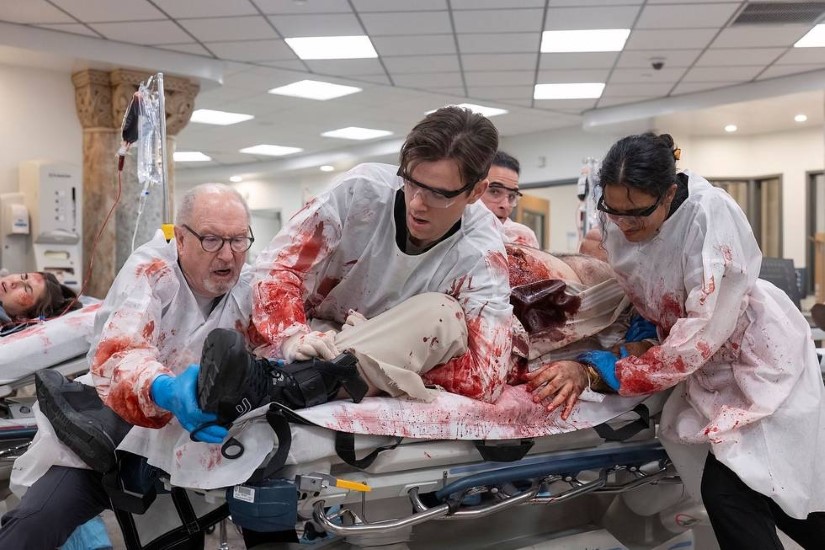
What was your approach to ‘gore’ in the show? What were the showrunner’s tastes in terms of how gruesome the injuries and medical procedures should sound?
BP: The showrunner has a pretty high tolerance for gore when the story and picture support it; it’s all about the accuracy of the procedure. I personally love the floating face in Ep. 102 and the Captain Morgan hip reset in Ep. 106.
The showrunner has a pretty high tolerance for gore when the story and picture support it
Of course, some scenes when the most blood is present are also the most dangerous and emotional scenes, and you don’t want to lose the audience with excessive gore, even if it’s realistic. So, there’s a balance — Ep. 111 comes to mind.
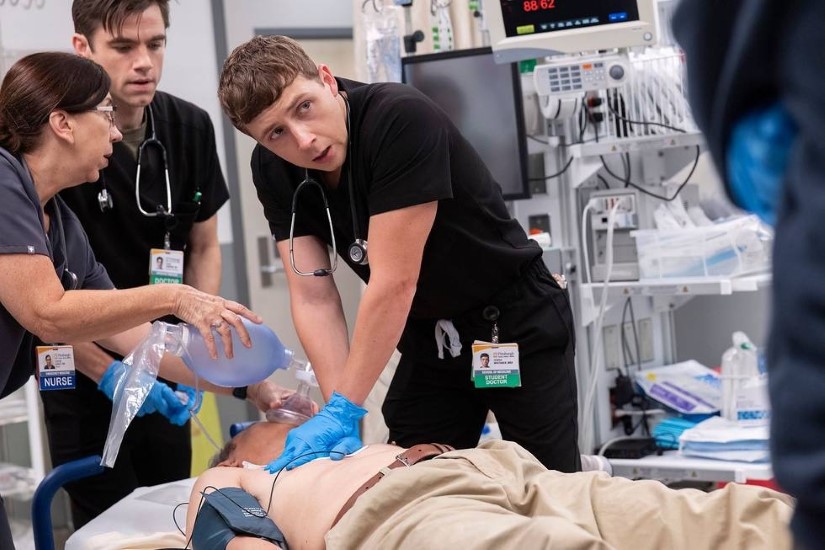
Who did your foley on The Pitt? What were some of their key contributions to sound on the show?
BP: Our foley team was Alex Ullrich (foley artist), Adam DeCoster (foley artist), and Alex Jongbloed (foley editor/mixer) from Aura Sound and Color. They did an incredible job.
I can tell they love the show, and it’s clear they go the extra mile with the detail they put in.
I went to our props department at the shooting stage at Warner Brothers and got some surgical tools, tubes, and equipment, and the foley team was so stoked about the bone rongeur, the surgical drapes, and the bougie. I can tell they love the show, and it’s clear they go the extra mile with the detail they put in.
They keep the ambu bags straight (the squeeze breathing bags) on and off cam; they handle all the details on the surgical tools in the trauma room. And, the precision they lend to guide wires and tubes helps the mix a ton.
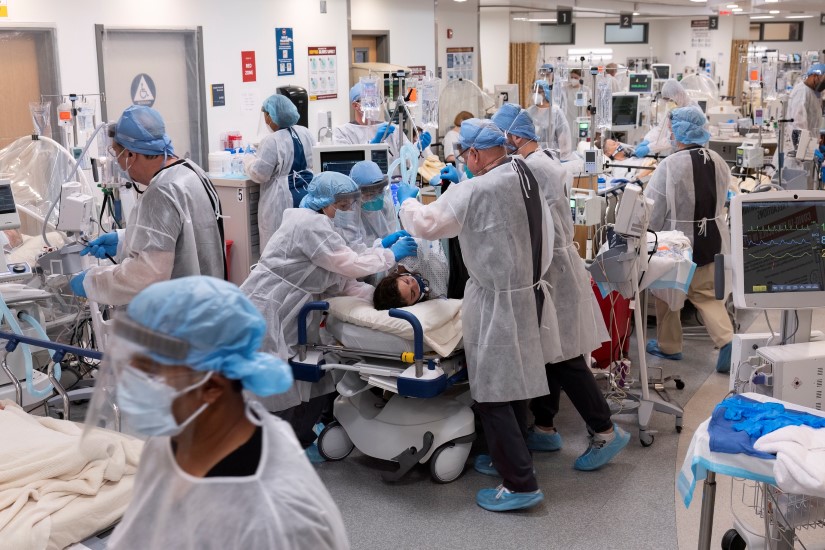
What was the most challenging episode for sound? Or, what episode required the most sound work? Can you talk about what went into your work on it?
BP: I guess Ep. 101 was the most challenging for me because I had to get up to speed on a lot of terminology and a lot of our producers’ preferences in a hurry.
I had to get up to speed on a lot of terminology and a lot of our producers’ preferences in a hurry
I had to build a way for a heart monitor to indicate that the heartbeat undergoing Atrial Fibrillation was “irregularly irregular” while maintaining an average rate in the correct range; before the episode was locked, I built the Trauma Corridor / degloved foot sequence several different ways so that the producers and the network could see different versions and decide how effective it could be with little or no music. We established doors, alarms, and lots of different equipment in that first episode that we carried through the rest of the season.
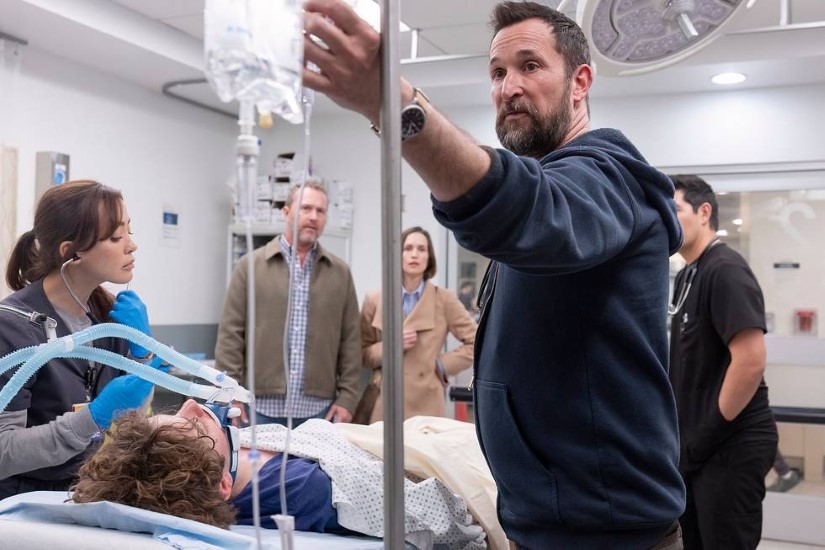
What have you learned while working on the sound of The Pitt? What will you carry with you from this experience?
BP: I’ve learned a lot of modern medical terminology and started to understand some concepts about certain procedures that, I hope, help me ask our medical advisor better questions and present an accurate sound for each scene. I hope to keep improving that understanding and do an even better job on Season 2!
A big thanks to Bryan Parker for giving us a behind-the-scenes look at the sound of The Pitt and to Jennifer Walden for the interview!


